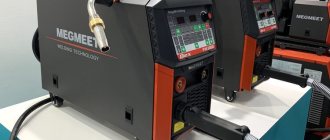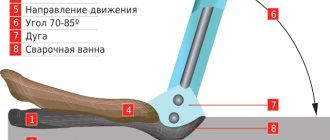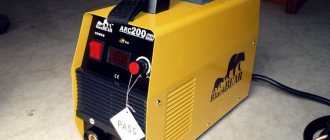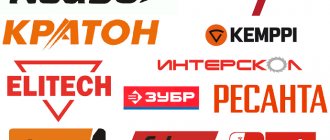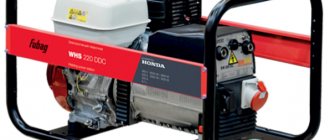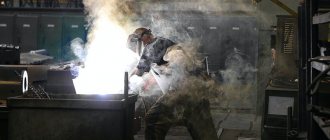Protect your eyes | 02/23/2016
Welding, as a type of joining metal elements, became widespread a little more than a century ago. However, today it is used in many fields of activity, from electronics production to the construction of giant structures. Since the composition of the metals used is very diverse, many types of equipment have been invented and implemented to obtain reliable welds. The most popular among them are welding machines. Let's look at what types of welding machines there are, the pros and cons of each.
How to choose a welding machine
The unit is selected to solve specific problems, therefore, it must have the following criteria:
- Have the necessary power. The main indicator is current strength.
With increasing power parameters, the ability to process thick workpieces (up to 6-8 mm), use electrodes of larger diameter (up to 4-5 mm), use long-term continuous operation increases, and the overall service life of the device increases.
For domestic purposes, it is advisable to choose a unit with a current strength of up to 200-250A.
- Mains voltage. 220 or 380 V. The last indicator is typical for industrial facilities. The device for home use must have protection against voltage surges.
The range in which the device operates stably is 180-240 V. Approaching the value 210-230 V indicates that the device is designed to operate in “ideal” conditions. It is better to avoid such structures.
- Idle speed indicator. It is determined by the voltage value at which the electric arc stably ignites and is maintained. It is advisable to make the choice according to the maximum indicators.
For a transformer - 80 V, a rectifier - 90 V, an inverter - up to 40–50 V.
- Continuous welding mode. Expressed as a percentage. The figure 40% means that the working period lasts 4 minutes, followed by a break of 6 minutes. The indicator depends on the current strength.
As electricity consumption decreases, operating time increases, and vice versa. When choosing a device, the cycle duration values should be overestimated by 20-30%.
- Functionality of the unit. Ability to work in protective gases, processing non-ferrous metals and alloys, extended load range.
- Working temperature. Determined by the manufacturer. The wider the range, the better. For household tasks, a unit that starts at t = – 5 – + 40°C is quite suitable.
- Degree of protection from moisture, dirt and dust. The optimal value is IP23 marking.
- Weight of the device. Important for frequent transfers of the unit from site to site.
Important parameters:
- Does the purpose of the device correspond to the fulfillment of the assigned tasks? The technical capabilities of the unit must allow it to process material of the required size.
- Power consumption and voltage must correspond to the capabilities of the electrical network.
- Workmanship. The material used for the main components and parts. A “clattering” device made of weak plastic, loose connections are an argument for refusing to purchase.
- Equipment. Full equipment will allow you not to purchase the necessary elements for work. The presence of a repair kit is an additional plus in favor of purchasing the unit.
- Appearance and condition of the equipment. Release date and sale date.
Secondary parameters:
- Color of the body and parts of the device, packaging. Functionality is not affected.
- Weight of equipment for permanent installation.
- The layout of the device, the location of the control knobs on the device body is a subjective perception. Does not affect the capabilities of the equipment.
The best semi-automatic welding machine
Inforce MIG-2800 is used for welding work. The design feature allows filler wire to be automatically fed into the arc formation zone.
The Inforce MIG-2800 model is an inverter. The unit performs three types of welding operations:
- manual arc with piece electrodes;
- semi-automatic in a protective gas environment;
- flux-cored wire without gas protective atmosphere.
The protective functions of the device allow it to operate with voltage deviations in the electrical network up to 15% of the nominal parameters.
Characteristics:
| Types of modes | without gas, in protective gas environment | Welding current value, A | 280 |
| Maximum power consumption, W | 7.2 | Optimal operating voltage, V | 220–230 |
| Power plug | provided | Minimum possible current, A | 30,0 |
| Wire dimensions, mm | Ø 0.8–1 | PV indicator at maximum operating current values | 60% |
| Security degree indicator | IP21S | Permissible differences in the electrical network | ±15% |
Pros:
- control over the dynamic characteristics of the device;
- optimal wire feed speed parameters: 1-12 m/min;
- low weight and dimensions in its class;
- the design is based on IGBT transistors;
- automatically selects optimal indicators (in the range of 15.5–60V) for operating current parameters;
- carrying out an efficient welding process while saving energy.
Minuses:
- The owners did not note any shortcomings.
Selection criteria - purpose of the unit, list of functions, price, possibility of mastering by a beginner. The main indicator is the stability of work and, accordingly, the quality of the seam.
The semi-automatic inverter Inforce MIG-2800 is perfect for professionals and beginners. Capable of working at a production level. Fulfills its main purpose - it is famous for its excellent weld quality.
Rating:
- Inforce MIG-2800;
- Aurora PRO OVERMAN 180 Mosfet 10041;
- SPECIAL MAG170 Invertor.
The best inverter type welding machine
An inverter is one of the sources of formation and power supply of an electric arc for welding work. The principle of operation is to convert the indicators of the electric mains current into the parameters necessary to ensure the welding process.
Reformatting of power quantities is carried out by a transformer and an electronic unit based on transistors. Reduction of rectified current ripple occurs in the inductor.
Inforce IN-200S is a mobile device with a wide range of operating currents (20-200A). Protective functions allow you to work when the external voltage drops to 140-150V. The device is equipped with a liquid crystal display.
Characteristics:
| PV indicator at maximum operating current values | 60% | Maximum output power, kW | 5.3 |
| Power plug | provided | Availability of posts | 1 |
| Operating voltage, V | 220–230 | Idle speed indicator, V | 80.0 |
| Operating current range, A | 20–200 | Security degree indicator | IP21S |
| Electrode (wire) size, mm | 1.6–5 | Efficiency, not less, % | 85 |
Pros:
- the functions “hot start”, arc forced, and anti-stick are provided;
- the ability to adjust the current during the working process;
- use of forced cooling;
- stability of welding arc performance;
- simple preparation and setup for work, simple operation;
- high quality indicators of the formed seam;
- ensuring stable operation during power surges and drops.
Minuses:
- difficult to read current indicators on the instrument scale;
- the presence of current surges due to changes in input voltage.
Indicators that need to be guided by taking into account Russian reality:
- power surges, this is especially true for small settlements and rural areas;
- power;
- electrode diameter;
- continuous operation time;
- seam quality;
- ease of use;
- price.
The optimal solution is the Inforce IN-200S welding inverter model.
Rating:
- Inforce IN-200S;
- Caliber MICRO SVI-205;
- Resanta SAI 190
Rules for choosing a device
The rules for choosing a device depend on what kind of welding machine will be used.
So, when purchasing transformers, it is recommended to pay attention to the following points:
- Operating voltage . Three-phase or single-phase 380/220 V devices are suitable for home use. You can also purchase a universal unit that is suitable for any type of voltage.
- Device power . It is not necessary to purchase the highest power device. The main thing is that the device is suitable for your home network.
- Operating current parameters and electrode sizes . In this case, it all depends on what material the device will be used for.
- Unit dimensions . The smaller the size, the easier it will be to select storage for the device and transport it.
When choosing rectifiers, it is recommended to focus on the following points:
- Presence of pulsed rectifier current . Only in this case the devices guarantee a stable arc and minimal metal spatter. In addition, such devices form a high-quality seam and do not require frequent replacement of consumables.
- Operating voltage . It must be suitable for your home network.
- Principles of adjustment of welding modes . This ensures the convenience of the procedure.
What welding machine do you use?
Semi-automaticInverter
Criteria for selecting inverter welding machines:
- Operating voltage . It must be suitable for your home network.
- Characteristics of currents and welding modes . In this case, it all depends on what thickness of material the device will be used for.
- Duration of PV switching on . How long the device will operate at maximum current will depend on this indicator. The bigger it is, the better.
- Power . This indicator determines whether the cable can be used to connect the device and whether the device will work without causing voltage surges.
- Supply voltage range . The ability to use the device during voltage surges depends on this indicator.
- Additional options . They increase the functionality and ease of use of the units.
The best transformer type welding machine
SPEC MMA 180 AC-S is distinguished by its simple design and low price (compared to other types of converters). The device connects metal products using the MMA method - manual arc welding with a stick electrode with flux coating.
The model is used for outdoor and indoor work. The design provides protection against overheating. There is a handle and wheels for moving the unit.
Characteristics:
| Current strength (min-max), A | 60–180 | Power limit, W | 7,7 |
| Mains voltage, V | 220/380 | Fast | 1 |
| Electrode size, mm | 2–4 | Idling, V | 48 |
| Total weight, kg | 16,8 | Protection degree indicator | IP21S |
Pros:
- simplicity of design;
- forced cooling;
- possibility of transportation;
- possibility of smooth adjustment of welding current parameters;
- simple setup, convenient control.
Minuses:
- a little heavy.
Selection criteria: current strength, electrode diameter, ease of control and price. The optimal choice is the SPEC MMA 180 AC-S transformer.
Rating:
- SPECIAL MMA 180 AC-S;
- SOROKIN 12.40;
- PRORAB FORWARD 130.
Types of welding machines depending on the type of welding
Having considered what types of welding machines there are by type of power source, let’s move on to their varieties according to welding modes.
Devices for manual arc welding MMA
These types of welding machines are built on the basis of inverters, transformers or rectifiers. The welder operates a holder on which the consumable electrode is fixed. The metal rod closes the arc on the workpiece and serves as a filler material. The outer coating, when melted, creates a gas cloud to protect the weld pool from the external environment.
Manual arc welding machine - MMA.
Application. This type of welding can join ferrous metals. If you install electrodes with a stainless steel rod, you will be able to weld alloy steel. But the speed of work is slow, you need enough experience to get a high-quality connection, and you constantly have to control the arc length as the electrode decreases.
Diagram of the electric arc welding process.
Watch a video about MMA welding machines:
Machines for semi-automatic MIG/MAG welding
MIG/MAG welding is called semi-automatic because the seam is made using a torch, but the wire inside is fed from a special mechanism from a reel. The principle of operation is similar to MMA, only instead of a holder there is a compact torch. The metal is connected by an electric arc (the ground cable is connected to the product, and the “plus” remains on the wire).
Semi-automatic welding machine - MIG/MAG.
Application. Thanks to the continuous supply of additive, long, neat seams can be created. There is no slag in the weld pool, so it is better for the welder to control it. Protection from the external environment is provided by gas supplied from the cylinder through the burner nozzle. This type of welding is fast and allows you to join metal with a thickness of 0.6 to 20.0 mm. Depending on the type of wire being installed, ferrous metal, stainless steel, and aluminum can be welded. But you need to carry a cylinder with you. Even when there is wind and work outside, the weld pool becomes defenseless (the supplied gas is blown away).
Diagram of the semi-automatic welding process.
Watch a video about semi-automatic MIG/MAG welding machines:
TIG welding machines
TIG welding is performed using inverters. There is also an electric arc here, but it burns between the product and a non-consumable tungsten electrode. The latter has a diameter of 1.6-3.2 mm and is sharpened in the form of a sharp cone. This allows you to create narrow seams. Connections can be made using only the edges being fused, or using an additionally supplied additive with the welder’s free hand. The weld pool is protected by argon blown from the torch nozzle.
Tig welding machine.
Application. When working with direct current, you can weld ferrous metals and stainless steel. There are types of welding machines with AC/DC function designed for welding aluminum. With such equipment you can cook very carefully and economically, but the speed of the method is significantly inferior to a semi-automatic one.
Scheme of the argon arc welding process.
Watch a video about welding machines for argon arc welding:
Universal welding machines
Universal models of welding machines combine several welding modes.
Here are the existing options:
- MMA+MIG. The model is capable of welding with coated electrodes and wire fed from the drum. In the first case, this is practical for cutting by electric welding, and in the second for serial production of sheet metal parts or body repairs.
- MIG+TIG. Semi-automatic with the possibility of connecting an argon burner. Allows you to quickly make seams on stainless steel and ferrous metal using the MIG mode, as well as join aluminum by switching to TIG.
- MMA+TIG. Inverter for welding with conventional electrodes and tungsten rods. Practical when alternating welding of ferrous and non-ferrous metals where high speed is not required.
- 3 in 1. The most versatile machines capable of welding in MMA, TIG and MIG modes. For this purpose, the front panel has several sockets for connecting the corresponding burners. Such equipment is purchased for a wide variety of tasks.
Spot welding machines
Spot welders come in models with pliers for double-sided welding or with a gun and reverse hammer for single-sided welding. The former are used for assembling thin-sheet structures (boxes, doors, gates, gates).
Device for spot welding on both sides.
The latter are used in body repair, when it is necessary to weld to a plane without access to the reverse side. There are manual portable models weighing up to 16 kg and stationary resistance welding machines. The thickness of the welded metal varies from 3 to 9 mm.
Single-sided spot welding machine.
Plasma welding machines
These types of devices use an electric arc burning in a nozzle between the cathode and anode. Compressed air from a compressor is passed through it, which forms plasma. Closing the mass on the product allows you to transfer the arc and make it not a duty arc, but a cutting arc. If you use filler wire, this method is suitable for welding parts.
Plasma welding machine.
Watch a video about plasma cutters:
Best rectifier welder
VD-306 SE is designed to form an electric arc and create a weld. The principle of operation is the conversion of alternating current into direct current. Rectification occurs through diode bridges. The work is carried out from one post.
The design is equipped with forced ventilation. It is possible to smoothly change the current strength. Stable welding arc performance ensures the creation of a reliable mechanical connection. The model is equipped with wheels for moving.
Characteristics:
| Current range, A | 60–315 | Input voltage, V | 380.0 |
| Maximum power, kW | 24.0 | Electrode diameter, mm | 2–6 |
| fast | 1 | Overall dimensions, cm | 63.4x47.3x51 |
| Idling, V | 70.0 | Total weight, kg | 96.0 |
| PV indicator at maximum mode | 60% |
Pros:
- stable electric arc performance;
- high quality weld;
- durable body;
- small overall dimensions and weight in its class;
- Convenient and quick connection of power cables.
Minuses:
- not noted.
It is advisable to evaluate a rectifier based on its functionality:
- work with a large list of metals;
- arc stability;
- duration of operation per work shift;
- price.
The VD-306 SE model is most preferable for solving production problems that arise in small-scale production and repair shops.
Rating:
- VD-306 SE;
- BlueWeld Omega 530 HD 819130;
- BARS VD-306 3 x 380.
Inverters
Devices of this type are also called pulsed. Today, welding inverters are considered one of the most common devices due to their light weight and general availability. And if 10 years ago inverters were expensive and not very reliable, now these shortcomings have been eliminated . The use of inverter technology today results in a reduction in the size of the transformer, an increase in the quality properties of the arc, optimization of efficiency, and a reduction in metal spatter during welding.
The welding inverter consists of a power transformer, the purpose of which is to reduce the mains voltage to the required value, a block of electrical circuits and a stabilizer choke, necessary to minimize current ripple.
The supply voltage is supplied to the rectifier in the inverter, at the output of which a circuit block transforms direct current into alternating current with a high frequency. This alternating current, obtained at the output of the power unit, is supplied to a high-frequency welding transformer, which is more compact and lighter than a conventional network converter. The voltage at the output of the welding transformer is rectified again and supplied to the arc.
